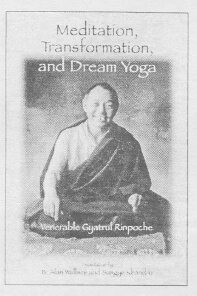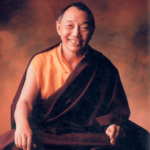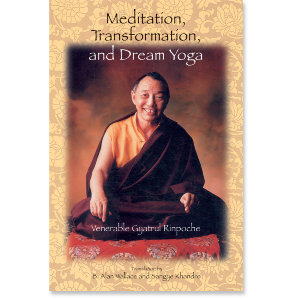| The following article is from the Summer, 2002 issue of the Snow Lion Newsletter and is for historical reference only. You can see this in context of the original newsletter here. |

This teaching was given to the Shambhala community in Boulder in the fall of 1991.
"Exercises are given which can be practiced by anyone in any circumstance."—The Tibet Journal
Three traditional Nyingma teachings were selected for contemporary Buddhists who want to improve the quality of their practice during the three periods of their day—during meditation, in their active life, and during sleep. Gyatrul Rinpoche, a respected teacher in the USA, expands and explains these texts.
Guidelines for calm abiding and insight meditation are presented from the Dzogchen perspective. Practices for bringing the daily experiences of pleasure and pain into the spiritual path are presented in the section on transformation. Finally, the teachings on dream yoga guide the practitioner in the conscious control of the dream state, as well as after death.
This book was previously published as Ancient Wisdom.
Gyatrul Rinpoche, who founded the Pacific Region Yeshe Nyingpo centers on the West, Coast, lives in Ashland, Oregon, and in Sedona, Arizona.
The following is an excerpt from Meditation, Transformation, and Dream Yoga.

What is the benefit of peacefully abiding, allowing the mind to remain still, in a natural state which is motionless? Until you are able to develop quiescence, you will not be able to control or suppress deluded mental afflictions. They will continue to arise and control the mind. The only way to get a handle on that and put an end to it is to accomplish quiescence. Once that is accomplished, all other spiritual qualities will arise from that basis, such as superknowledge, clairvoyance, the ability to see into the minds of others, to recall the past, and so forth. These are mundane qualities that arise on the path but are developed only after the mind can abide peacefully. Qualities such as heightened awareness and clairvoyance must be developed, because it is through them that one is able to understand and realize the fundamental nature of the mind. As it says in the Bodhicharyavatara, one of the most important mahayana texts, "Having developed enthusiasm in this way, I should place my mind in concentration; for one whose mind is distracted dwells between the fangs of mental afflictions."
An individual who has been able to accomplish quiescence will no longer be overpowered by attachment to ordinary activities and contact with worldly people. The mind automatically turns from attachment and attraction to cyclic existence, because quiescence is the experience of mental contentment and bliss which is far more sublime than ordinary attractions that arise from confused perception. When the mind is at peace, it can then be directed to concentrate undistractedly for indefinite periods of time. Quiescence destroys delusion because mental afflictions do not arise when one is experiencing the equipoise of single-pointed concentration.
People who have achieved quiescence naturally experience compassion as they view the predicament in which other living beings are ensnared. Pure compassion arises as they begin to clearly perceive the nature of emptiness in all aspects of reality. These are only a few of many qualities as taught by the Buddha which are the direct result of accomplishing quiescence.
Quiescence is the preparation and basis for the main practice which is the cultivation of the primordial wisdom of insight. These two meditations are complimentary. The success that one has in developing insight is dependent on the success that one has with developing quiescence. If you are able to develop quiescence only to a certain degree, then your experience of insight will be limited. However, if you are able to fully accomplish quiescence, then you will be able to fully perfect insight as well. If that is the case, then that is as good as saying perfect enlightenment will be realized.
Now as for accomplishing quiescence, initially you should try to practice in a place which is isolated, quiet, and comfortable. It is important to feel comfortable and content in the place you have chosen to meditate. After arranging a comfortable cushion to be seated upon, assume a very straight sitting posture. The seven-point posture of Buddha Vairocana is ideal. Otherwise, be sure to sit so that the spine is erect. If you are sitting in a cross-legged position, then the best position to sit in is the full lotus. If you are unable to sit in full lotus, you can sit in a cross-legged position and elevate your buttocks a bit so that your back will be straight. Otherwise you may sit in a chair so that your back is straight. Keeping your spine straight, you should bend your head down a bit so that the chin is slightly tucked in and allow the gaze to go out over the tip of the nose. Allow the tip of the tongue to barely touch the roof of the mouth in a natural way so that the mouth is neither tightly closed nor gaping open. The arms and hands should be down to the sides. If you are sitting in a cross-legged position, the hands can be placed right over left in your lap. Otherwise, if you are sitting in a chair, they can hang naturally.
The sitting posture is very important and so is the position of the speech. Allow the speech to be silent—no talking, no making of sounds, just natural breathing. There is nothing else to do other than remain calm and natural.
The position of the mind is to avoid recalling events of the past, anticipating future events, and contriving or controlling the present moment, just allow yourself to remain natural and at ease. Whatever arises should be allowed to be as it is without alteration or adjustment.
To "allow your mind to rest in the natural state" is easier said than done. The main reason for that is because, from countless past lifetimes until now, you have established habitual instincts, mental impressions that make your mind chaotic and full of countless varieties of conceptual proliferations. In order to achieve peace, you must employ techniques. This does not mean that you should try to control thoughts by recalling, anticipating, or altering the experience. But rather, as you begin, you should attempt to place the mind upon an object so that the mind can focus and calm down. The use of objects on which to place the mind corresponds to the three kayas. The first step is the nirmanakaya method and is accomplished by using an image of Buddha Shakyamuni appearing as the nirmanakaya buddha (embodiment of intentional manifestation). An image of Buddha Shakyamuni is positioned directly in front of you so that you will gaze naturally upon it.

The mind automatically turns from attachment and attraction to cyclic existence, because quiescence is the experience of mental contentment and bliss which is far more sublime than ordinary attractions that arise from confused perception.
The second step is the sambhogakaya method accomplished by using an image of Vajrasattva appearing as the sambhogakaya buddha (embodiment of complete rapture). The third step, the dharmakaya method, is accomplished by visualizing an image of Vajradhara in the center of the heart. Once quiescence is accomplished in these three stages, you are ready to begin quiescence practice with no elaborations at all.
If you do not possess any of these images of the Buddha, the practice can still be carried out. You may use a stone, a stick, a flower, or something natural that is found in the environment and that costs nothing. Simply practice with that object directly in front of you exactly as you would practice with the image. Ideally the object should be about four finger-widths wide. The mind should remain single-pointedly focused upon that object without any other distraction. While allowing your gaze to remain single-pointedly focused upon the statue or object, notice what your mind is doing while you are trying to focus. There should be no attempt to generate a visualization as you would in generation-stage practice. You are simply looking at the image with single-pointed concentration, nothing else.
When you are practicing for more extended periods of time, you may experience the mind becoming dull and sleepy. When that starts to happen—and it is a common reaction—you should straighten up your body, readjust your position, and move your gaze to the uppermost part of the image upon which you are focused. If, on the other hand, you find that the mind starts becoming more chaotic with an abundance of thoughts, then you should lower the gaze to the Buddha's navel center or seat or to the lower part of the object, trying to relax. If the mind becomes chaotic, too much effort is being applied. If there seems to be no extreme reaction and things are progressing fairly well, then you can maintain your view at the heart center of the image.
This stage of the practice may be maintained for however long is necessary, until you are able to maintain your concentration for an extended period of time without the distraction of disturbing thoughts.


